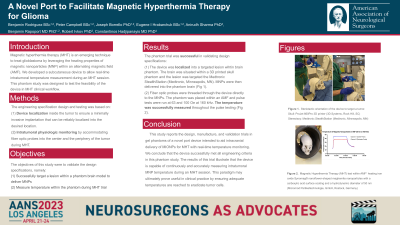A Novel Port to Facilitate Magnetic Hyperthermia Therapy for Glioma
Friday, April 21, 2023


Benjamin Rodriguez (he/him/his)
Student
Icahn School of Medicine
ePoster Presenter(s)
Introduction: Magnetic hyperthermia therapy (MHT) is an emerging technique to treat glioblastoma by leveraging the heating properties of magnetic nanoparticles (MNP) within an alternating magnetic field (AMF). MNPs must surpass 45oC to kill tumor cells, while remaining below 55oC to avoid killing healthy cells, but currently there is no modality to directly measure intratumoral temperature during MHT sessions. We developed a subcutaneous device to allow real-time intratumoral temperature measurement during an MHT session. This phantom study was designed to test the feasibility of the device (ThermOmmaya) in MHT clinical workflow.
Methods: The device was implanted in a polyvinyl alcohol skull phantom model; 400 microliters of iron oxide MNPs were delivered into a lesion via the device. Two fiber optic probes were then localized into the lesion, one centrally located within the MNPs and one at the periphery. This phantom model was then placed in an AMF and subjected to clinical standard magnetic field ranges.
Results: Using an average magnetic field of 55 Oe at 160 kHz, the temperature of the MNPs was continuously measured within the lesion. A rapid 31°C increase in temperature of the nanoparticles (13.8°C to 45°C) was observed in 53 seconds. Upon reaching a temperature of 45°C +/- .9°C an average temperature of 44.8°C was maintained for 15 minutes. There was no excessive heating observed when conducting this test in the AMF and the temperature of the nanoparticles returned to body temperature (37°C) 30.3 seconds after the magnetic field was deactivated.
Conclusion : The results of this trial illustrate that the device is capable of continuously and accurately measuring intratumoral MNP temperature during an MHT session. This paradigm may ultimately prove useful in clinical practice by ensuring adequate temperatures are reached to eradicate tumor cells.
Methods: The device was implanted in a polyvinyl alcohol skull phantom model; 400 microliters of iron oxide MNPs were delivered into a lesion via the device. Two fiber optic probes were then localized into the lesion, one centrally located within the MNPs and one at the periphery. This phantom model was then placed in an AMF and subjected to clinical standard magnetic field ranges.
Results: Using an average magnetic field of 55 Oe at 160 kHz, the temperature of the MNPs was continuously measured within the lesion. A rapid 31°C increase in temperature of the nanoparticles (13.8°C to 45°C) was observed in 53 seconds. Upon reaching a temperature of 45°C +/- .9°C an average temperature of 44.8°C was maintained for 15 minutes. There was no excessive heating observed when conducting this test in the AMF and the temperature of the nanoparticles returned to body temperature (37°C) 30.3 seconds after the magnetic field was deactivated.
Conclusion : The results of this trial illustrate that the device is capable of continuously and accurately measuring intratumoral MNP temperature during an MHT session. This paradigm may ultimately prove useful in clinical practice by ensuring adequate temperatures are reached to eradicate tumor cells.
